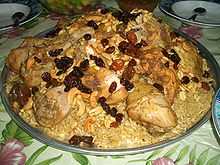Saudi Arabian cuisine
Traditional Cuisine
Food
The Saudi Arabian people have consumed the same type of food for thousands of years.[1]Some of the common food items in Saudi Arabian cuisine include; wheat, rice, lamb, chicken, yogurt and dates. A dish called Shawarma and Falafel are also very common. Yogurt is normally made into a drink called Laban.

Drink
Traditional coffeehouses used to be ubiquitous, but are now being displaced by food-hall style cafes. According to the Saudi Arabian Cultural Mission, "serving coffee (gahwa) in Saudi Arabia is a sign of hospitality and generosity. Traditionally, the coffee beans were roasted, cooled and ground in front of the guests using a mortar and pestle. The host would then add cardamom pods to the coffee beans during the grinding process. Once the coffee is brewed, it is poured for guests. Today, gahwa is not prepared in front of the guests, instead it is elegantly served in a dallah (Arabic style Kettle) and poured into small cups called finjan. [2] Drinking tea is also a famous custom in Arabia, It is used in both casual and formal meetings between friends, family and strangers. The tea is black (without milk) and has herbal flavoring that comes in many variations. Sheep, goat and camel milk are also used by the Bedouin.
Islamic Dietary Laws
Islamic dietary laws forbid the eating of pork and the drinking of alcoholic beverages. This law is enforced throughout Saudi Arabia. According to Islamic law, animals must be butchered in a halal way and blessed before they can be eaten. In 2008, Saudi Arabia was the world's fifth largest importer of both lamb and mutton.
According to the Saudi Arabian cultural mission, "guests are served hot coffee and dates as a symbol of generosity and hospitality. The same practice is carried out in the month of Ramadan. Muslims in Saudi Arabia break their fast with dates, water and arabian coffee. The caffeine in the coffee and the protein and iron in dates nourishes the fasting person with a lot of energy. This helps them perform the Tarawih held in the evenings during Ramadan." [3]
Food Shopping and Markets
Both Western-style grocery stores and typical Arabian marketplaces are plentiful in Saudi Arabia. For those that prefer wide aisles, stainless steel carts and a single location for shopping, the Kingdom aptly caters with popular chain stores like Tamimi, Panda, Othaim, Carrefour, Danube, LuLu, and Halwani. The expat population in Saudi Arabia may feel at ease in the company of so many English labels, but often many of the goods are imported and are proportionately expensive. As an alternative, Saudi Arabian vegetable markets source some of the freshest produce at negotiable prices. Each of the big city neighborhoods tend to have their own markets. Frequenting particular stalls and developing relationships with vendors can often help to reduce prices or inspire "specials".
Fast Food

Fast food, pizza and sit-down restaurant chains are popular in Saudi Arabia. One of the most famous local fast food chains is Al-Baik, which is based in Jeddah with branches throughout the western province of the country. American fast food chains in the country include restaurants such as Burger King, McDonalds, Hardee's, KFC, Pizza Hut, Domino's Pizza and Papa John's.
International Cuisine
Saudi Arabia is a major investment to world-renowned cuisine food chains which established several branches all over the kingdom. This includes Lenôtre, L'Entrecôte, Jollibee, Ashton Kutcher's Ketchup, The Melting Pot, The Noodle House, Ladurée and many more. Due to the large numbers of immigrants, foreign workers and people visiting the country to perform Hajj, the Saudi cuisine was influenced by a variety of cuisines from different parts of the Muslim world. This introduced the country to food such as Mutabak, Manto and Ful.
See also
References
External links
- Saudi Cooking
- Davies, Catriona. "Saudi foodies ditch fast food for fine dining." CNN. Wednesday March 28, 2012.
| ||||||||||||||||||||||||||||||||||||||||||||||||||
| |||||||||||

